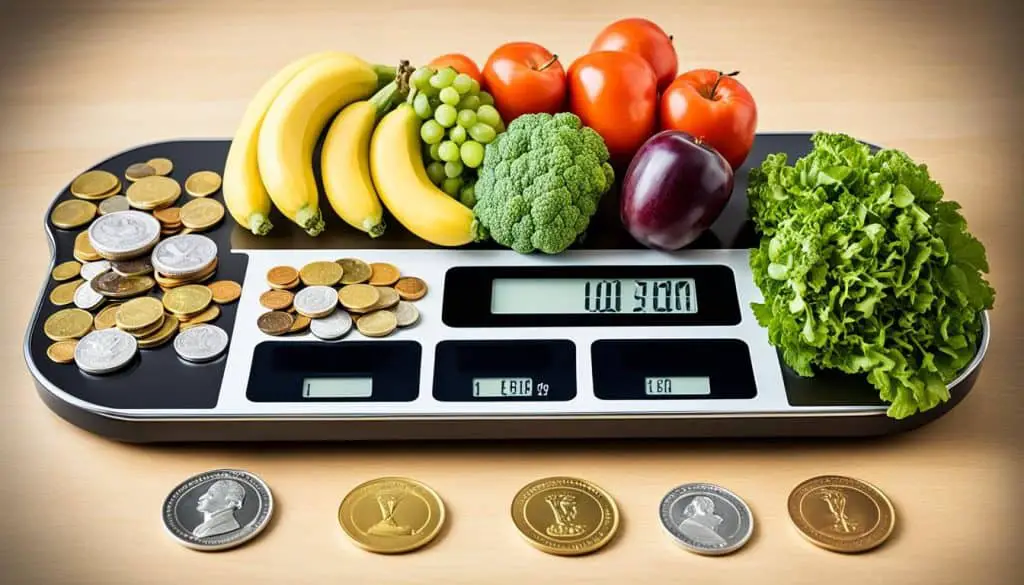
Are you looking to embark on a 5-month weight loss journey? Wondering how much weight you can lose in 150 days? Let’s dive into the details! Planning an effective and sustainable weight loss program requires careful consideration of various factors to help you achieve your goals.
It’s important to start by setting realistic expectations and consulting with a healthcare professional who can guide you on your weight loss strategy. Keep in mind that everyone’s weight loss journey is unique, and the amount of weight you can lose in 150 days may vary based on individual circumstances.
To calculate how much weight you can lose in 150 days, you need to consider factors such as your current weight, goal weight, and daily calorie needs. It’s crucial to understand that the commonly believed notion that a deficit of 3,500 calories leads to one pound of weight loss is actually an overestimation.
Your daily calorie needs are influenced by various factors, including your basal metabolic rate, age, sex, height, and activity level. It’s important to determine your estimated daily energy needs using a weight loss calculator that takes into account these factors. By understanding these calculations, you can create a calorie deficit by consuming fewer calories than your body requires.
Incorporating exercise into your weight loss plan can also help you achieve your goals more effectively. Engaging in cardiorespiratory exercise, resistance training, and interval training can contribute to burning calories, improving cardiovascular fitness, building lean muscle mass, and boosting metabolism.
Once you have achieved your desired weight loss, it’s crucial to focus on maintaining your progress. This involves adopting healthy habits such as regular physical activity, keeping a food journal, and monitoring your weight through regular weigh-ins. Additionally, making long-term behavior changes and gradually incorporating small adjustments into your daily routine will contribute to sustainable weight loss.
Key Takeaways:
- Consult with a healthcare professional to guide you on your weight loss journey.
- Calculate your estimated daily energy needs to create a calorie deficit.
- Incorporate exercise into your weight loss plan for enhanced results.
- Maintain your weight loss by adopting healthy habits and making long-term behavior changes.
- Remember that sustainable weight loss is a gradual process, so be patient and consistent.
Factors Affecting Daily Calorie Needs
Your daily calorie needs are influenced by various factors that play a crucial role in determining the amount of energy your body requires on a daily basis. These factors include:
- Basal Metabolic Rate (BMR): Your basal metabolic rate refers to the amount of energy your body needs to perform basic functions while at rest. It accounts for the calories your body burns to maintain essential processes like breathing and circulating blood.
- Age: As we age, our metabolic rate tends to slow down. This means that older individuals generally require fewer calories compared to younger individuals.
- Biological Sex: Biological sex also plays a role in calorie needs. Men typically have higher calorie needs due to their larger body frames and higher muscle mass compared to women.
- Height: Taller individuals tend to have higher calorie needs to support their body mass. This is because larger bodies require more energy to function.
- Activity Level: The more physically active you are, the more calories you need to maintain your weight. Regular exercise and physical activity increase calorie expenditure and can influence your daily calorie needs.
To determine your estimated daily calorie needs, you can use a weight loss calculator that takes into account factors such as your current weight, goal weight, and desired timeframe for weight loss. This can provide you with an approximate daily calorie target to aim for.
It’s important to note that individual variation exists, and it’s always best to consult with a healthcare professional or registered dietitian for personalized guidance regarding your specific calorie needs and weight loss goals.
Body Mass Index (BMI)
Body Mass Index (BMI) is another useful tool for assessing weight and determining appropriate calorie needs. BMI is a calculation that takes into account your weight and height to provide an estimate of body fat. It categorizes individuals into different weight categories, such as underweight, normal weight, overweight, and obese. While it does not directly measure body fat percentage, it is a commonly used screening tool in healthcare settings.
BMI can be calculated using the following formula:
BMI = (Weight in kilograms) / (Height in meters)^2
Based on your BMI, you can determine whether you fall within a healthy weight range and use this information as part of your overall weight management strategy.
| Category | BMI Range |
|---|---|
| Underweight | Less than 18.5 |
| Normal Weight | 18.5 – 24.9 |
| Overweight | 25 – 29.9 |
| Obese Class I | 30 – 34.9 |
| Obese Class II | 35 – 39.9 |
| Obese Class III | 40 or higher |
Creating a Calorie Deficit for Weight Loss
To achieve weight loss, it is essential to create a calorie deficit by consuming fewer calories than your body requires. This can be accomplished through various strategies, including portion control, choosing nutrient-dense foods, and avoiding high-fat and high-calorie options. By implementing these techniques, you can create a calorie deficit and promote weight loss effectively.
When determining your daily calorie intake for weight loss, it is crucial to consider your individual needs. Factors such as sex and activity level play a significant role in determining the recommended calorie range. Women generally aim for a daily intake of no fewer than 1,200-1,300 calories, while men typically target no fewer than 1,400-1,500 calories. Consulting with a healthcare professional or registered dietitian can provide personalized guidance and help you establish the appropriate calorie deficit for your specific needs.
In addition to reducing caloric intake, engaging in regular physical activity can further support weight loss efforts. Combining exercise and a calorie deficit can enhance the overall effectiveness of your weight loss plan. Incorporating activities that you enjoy, such as cardiorespiratory exercises like walking, jogging, or cycling, can help burn additional calories and improve cardiovascular fitness.

Resistance training, which includes lifting weights or using resistance bands, can also aid in weight loss by building lean muscle mass and increasing metabolism. Interval training, involving alternating between high-intensity and lower-intensity exercise, is another effective method for burning calories and promoting weight loss.
| Gender | Recommended Daily Calorie Range for Weight Loss |
|---|---|
| Women | 1,200-1,300 calories |
| Men | 1,400-1,500 calories |
By adhering to a calorie deficit and incorporating regular exercise, you can optimize your weight loss journey and reach your goals effectively. Remember, creating a sustainable calorie deficit based on your individual needs is key to achieving long-term weight loss.
Incorporating Exercise for Weight Loss
In addition to creating a calorie deficit through dietary changes, exercise plays a vital role in achieving effective weight loss. By incorporating various types of exercise into your weight loss plan, you can maximize your results and improve overall fitness.
Cardiorespiratory Exercise
Cardiorespiratory exercise, also known as aerobic exercise, is an excellent way to burn calories and improve cardiovascular fitness. Activities such as walking, jogging, cycling, or swimming increase your heart rate and breathing, helping you shed excess weight.
Resistance Training
Resistance training, which includes activities like lifting weights or using resistance bands, is crucial for building lean muscle mass. More muscle mass improves metabolism and helps burn more calories, even at rest. Incorporating resistance training into your routine can enhance weight loss and shape your body.
Interval Training
Interval training involves alternating between high-intensity exercise and lower-intensity recovery periods. This type of training can effectively boost calorie burn and increase fat loss. High-intensity interval training (HIIT) is a popular form of interval training and can be done with various exercises, such as running, cycling, or bodyweight moves.
Physical Activity Guidelines
To support your weight loss efforts, it’s important to follow the physical activity guidelines. These guidelines recommend at least 150 minutes of moderate-intensity exercise per week, such as brisk walking or dancing. Alternatively, you can engage in 75 minutes of vigorous-intensity exercise, such as running or swimming, every week.
Remember to mix different types of exercise, such as cardiorespiratory exercise, resistance training, and interval training, to ensure a well-rounded fitness routine. This variety not only promotes weight loss but also improves overall strength, endurance, and flexibility.
Maintaining Weight Loss
Once you have achieved your desired weight loss, it’s important to focus on maintaining your progress. This involves adopting healthy habits such as regular physical activity, keeping a food journal to track your eating habits, and monitoring your weight through regular weigh-ins. Staying accountable to your goals and making adjustments as needed can help you maintain your weight loss and prevent regain. Incorporating a variety of exercises and activities into your routine can also help prevent boredom and maintain your motivation.
Healthy Habits for Weight Maintenance
- Engaging in regular physical activity: Physical activity is essential for weight maintenance and overall health. Aim for at least 150 minutes of moderate-intensity exercise per week, such as brisk walking, swimming, or cycling.
- Keeping a food journal: Tracking your eating habits can help you become more aware of your food choices and portion sizes. This can also help identify any patterns or triggers that may lead to overeating.
- Regular weigh-ins: Monitoring your weight on a regular basis can help you stay aware of any fluctuations and take timely action if needed. It’s important to remember that weight naturally fluctuates throughout the day and week, so focus on long-term trends rather than day-to-day changes.
- Finding an accountability partner: Having someone to support and hold you accountable can greatly increase your chances of maintaining weight loss. This could be a friend, family member, or even a support group or online community.
By incorporating these healthy habits into your lifestyle, you can create a solid foundation for long-term weight maintenance. Remember that sustainable weight loss is not just about reaching a number on the scale, but about adopting a healthy and balanced lifestyle.

The Importance of Behavior Change
One of the most critical aspects of successful weight loss is making long-term behavior changes. Instead of trying to make sweeping changes all at once, I recommend focusing on making small adjustments to your daily routine and sticking with them until they become sustainable habits.
“The secret of getting ahead is getting started.”
– Mark Twain
To achieve lasting results, it’s essential to prioritize healthy choices and embrace gradual progress. This could include gradually increasing your exercise duration or intensity, making healthier food choices, and finding ways to incorporate more physical activity into your daily life.
“Success is the sum of small efforts, repeated day in and day out.”
– Robert Collier
The Power of Small Adjustments
When it comes to behavior change, small adjustments can have a significant impact. Rather than overwhelming yourself with drastic changes, start by making tiny modifications that you can sustain over time. For instance, instead of eliminating certain foods entirely, focus on reducing your portion sizes or choosing healthier alternatives.
- Gradually increase your exercise duration by adding a few extra minutes each week.
- Swap sugary snacks for fruit or nuts to nourish your body with healthier options.
- Take frequent short walks throughout the day to boost your overall physical activity level.
“The journey of a thousand miles begins with a single step.”
– Lao Tzu
Cultivating Sustainable Habits
Creating sustainable habits is key to long-term success on your weight loss journey. Rather than focusing on quick fixes or temporary solutions, aim to adopt behaviors that you can maintain indefinitely. Take it one step at a time, and be patient with yourself as you navigate this process.
| Benefits of Behavior Change for Weight Loss | How to Cultivate Sustainable Habits |
|---|---|
| Improved overall health and well-being | Set clear, attainable goals |
| Consistent weight loss progress | Create a routine and stick to it |
| Increased energy levels | Practice self-care and prioritize your well-being |
| Enhanced self-confidence and body image | Find an accountability partner or join a support group |
“The only way to make sense out of change is to plunge into it, move with it, and join the dance.”
– Alan Watts
Remember, weight loss is a gradual process that requires patience and consistency. By focusing on behavior change and cultivating sustainable habits, you can achieve your goals and maintain a healthier lifestyle in the long run.
Conclusion
In conclusion, the journey towards successful weight loss in 150 days is achievable through a combination of lifestyle changes, small adjustments, and positive habits. By creating a calorie deficit through dietary changes and incorporating regular exercise into your routine, you can make significant progress towards your weight loss goals. Remember that long-term success lies in making sustainable choices and embracing a gradual approach.
During your weight loss journey, it is essential to focus on small, realistic changes to your lifestyle. These changes may include portion control, incorporating nutrient-dense foods into your diet, and avoiding high-fat and high-calorie options. By making these adjustments, you can create positive habits that will support your weight loss efforts.
Additionally, seeking guidance from healthcare professionals or registered dietitians is crucial. They can provide personalized advice and support tailored to your individual needs. Remember, your weight loss journey is unique, and consulting with experts will help you navigate any challenges and ensure your success.
calFAQ
How much weight can I lose in 150 days?
The amount of weight you can lose in 150 days depends on various factors such as your current weight, goal weight, and daily calorie needs. It’s best to consult with a healthcare professional to determine a realistic and healthy target for weight loss.
What is a 5-month weight loss plan?
A 5-month weight loss plan is a time frame of 150 days dedicated to achieving weight loss goals. It typically involves creating a calorie deficit through a combination of healthy eating habits and regular physical activity.
How can I create an effective weight loss program?
To create an effective weight loss program, it is important to consider factors such as your current weight, goal weight, and daily calorie needs. Consult with a healthcare professional or registered dietitian for personalized guidance and support.
What are some tips for healthy and sustainable weight loss?
Some tips for healthy and sustainable weight loss include setting realistic goals, creating a calorie deficit through a balanced diet, incorporating regular physical activity, and staying consistent with your efforts. Consulting with a healthcare professional or registered dietitian can provide additional guidance.
What is the best strategy for achieving my weight loss goals in 5 months?
The best strategy for achieving weight loss goals in 5 months is to create a calorie deficit through a combination of dietary changes and exercise. It is important to set realistic goals, consult with a healthcare professional, and stay consistent with your efforts.
What are some effective weight loss tips?
Some effective weight loss tips include portion control, making nutrient-dense food choices, avoiding high-fat and high-calorie foods, engaging in regular physical activity, and staying accountable to your goals. Consulting with a healthcare professional or registered dietitian can provide personalized advice.
What is the best way to lose weight in 5 months?
The best way to lose weight in 5 months is to create a calorie deficit through a combination of healthy eating habits and regular physical activity. It is important to set realistic goals, consult with a healthcare professional, and stay consistent with your efforts.
Source Links
- https://www.everydayhealth.com/weight/weight-loss-calculator/
- https://www.livestrong.com/article/169050-how-to-lose-about-20-pounds-in-5-6-months-keep-it-off/
- https://www.nbcnews.com/better/health/what-5-months-consistent-healthy-weight-loss-looks-ncna829356
Hey there, I’m Luke, and I’ve been immersed in the fitness world since 2007. From gym floors to running my own personal training business, I’ve seen it all. My journey led me to study Sports Science at university, where I deepened my understanding of the science behind exercise.
One thing that truly lights my fire? High-Intensity Interval Training (HIIT). It’s not just a workout; it’s a game-changer. I’ve used HIIT to help countless men and women shed weight and transform their lives for the better.
Through my personal training business, I’ve witnessed the incredible impact of HIIT on both physical and mental well-being. It’s not just about getting fitter; it’s about feeling stronger, more confident, and more resilient.
Join me on this journey to a healthier, happier you. Let’s crush those goals together!

